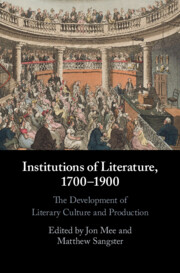Book contents
- Institutions of Literature, 1700–1900
- Institutions of Literature, 1700–1900
- Copyright page
- Contents
- Figures
- Contributors
- Acknowledgements
- Introduction Literature and Institutions
- Chapter 1 Knowledge Exchange in the Seventeenth Century
- Chapter 2 ‘Supporting Mutual Benevolence’
- Chapter 3 Institutions without Addresses
- Chapter 4 Eighteenth-Century Musenhof Courts as Bridges and Brokers for Cultural Networks and Social Reform
- Chapter 5 Becoming Institutional
- Chapter 6 Circulating Libraries as Institutional Creators of Genres
- Chapter 7 Lecturing Networks and Cultural Institutions, 1740–1830
- Chapter 8 Catalogues as Instituting Genres of the Nineteenth-Century Museum
- Chapter 9 Charles Lamb and the British Museum as an Institution of Literature
- Chapter 10 A Disruptive and Dangerous Education and the Wealth of the Nation
- Chapter 11 ‘The Ladies’ Contribution’
- Chapter 12 ‘[L]etters Must Increase’
- Chapter 13 Networks, Nodes, and Beacons
- Chapter 14 The Book as Medium
- Index
Chapter 7 - Lecturing Networks and Cultural Institutions, 1740–1830
Published online by Cambridge University Press: 30 June 2022
- Institutions of Literature, 1700–1900
- Institutions of Literature, 1700–1900
- Copyright page
- Contents
- Figures
- Contributors
- Acknowledgements
- Introduction Literature and Institutions
- Chapter 1 Knowledge Exchange in the Seventeenth Century
- Chapter 2 ‘Supporting Mutual Benevolence’
- Chapter 3 Institutions without Addresses
- Chapter 4 Eighteenth-Century Musenhof Courts as Bridges and Brokers for Cultural Networks and Social Reform
- Chapter 5 Becoming Institutional
- Chapter 6 Circulating Libraries as Institutional Creators of Genres
- Chapter 7 Lecturing Networks and Cultural Institutions, 1740–1830
- Chapter 8 Catalogues as Instituting Genres of the Nineteenth-Century Museum
- Chapter 9 Charles Lamb and the British Museum as an Institution of Literature
- Chapter 10 A Disruptive and Dangerous Education and the Wealth of the Nation
- Chapter 11 ‘The Ladies’ Contribution’
- Chapter 12 ‘[L]etters Must Increase’
- Chapter 13 Networks, Nodes, and Beacons
- Chapter 14 The Book as Medium
- Index
Summary
This chapter asks how social networks form institutions, and whether this process means that institutions are only networks by another name. Its method is to trace networks of scientific lecturing in the long eighteenth century that eventually culminated in establishing new scientific and literary lecturing institutions in Glasgow and London around 1800. For the most part not studied since the 1960s, itinerant scientific lecturers formed pathways across northern and southern England that can be called decentered networks linking various provincial cultures before they crystallized in new institutional experiments like Anderson’s Institution at Glasgow in 1796 and the Royal Institution in London in 1800. The chapter focuses most closely on the forming of the Royal Institution out of disparate networks, from 1796 to 1802, and the process by which the gathering of those networks also created conditions for their mutation into the Royal Institution that Romantic audiences and lecturers knew in the early nineteenth century. More broadly it asks what kind of institutional values or mission statements make an institution more accountable to social and political critique than networks themselves would be capable of sustaining.
Keywords
- Type
- Chapter
- Information
- Institutions of Literature, 1700–1900 , pp. 135 - 156Publisher: Cambridge University PressPrint publication year: 2022



